Family name: Amaranthaceae Jussieu
Synonym(s): Achyranthaceae Raf.; Atriplicaceae Juss.; Blitaceae Post & Kuntze; Deeringiaceae J. Agardh; Chenopodiaceae Vent., Corispermaceae Link, nom. inval.; Dysphaniaceae Pax, nom. cons.; Salicorniaceae Martinov; Salsolaceae Menge
Common name(s): amaranth family
*Number of genera/species: 165/2,040
List of genera records in GRIN-Global for Amaranthaceae and Chenopodiaceae
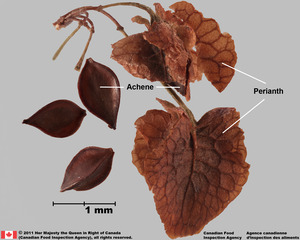 or bracts) or seed
or bracts) or seed
Fruit a utricleutricle:
a small, indehiscent, dry fruit with a thin wall (bladderlike) that is loose and free from the seed, derived from a single, superior, simple ovary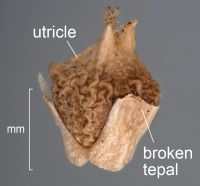 , acheneachene:
, acheneachene:
a dry, indehiscent, one-seeded fruit, with seed attached to pericarp at a single point, derived from a single, superior, simple or compound, one-loculed ovary , nutnut:
, nutnut:
a fairly large, indehiscent, dry fruit with a thick and bony wall surrounding a single seed, derived from a single, simple or compound ovary , or berryberry:
, or berryberry:
an indehiscent, fleshy fruit with one or a few to many seeds. The flesh may be homogenous throughout. Or, if the outer part is hard, firm, or leathery, referred to as an hesperidium. Septa are present in some, and the seeds may be arillate or with a fleshy testa. , or circumscissilecircumscissile:
, or circumscissilecircumscissile:
(~pyxis); type of capsular dehiscence, opens by a lid (splitting transversely)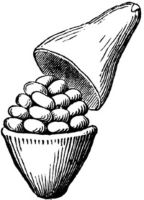 capsulecapsule:
capsulecapsule:
a dry, dehiscent fruit derived from a compound ovary , 0.5–12 mm long (with bracteoles, up to 25 mm), globoseglobose:
, 0.5–12 mm long (with bracteoles, up to 25 mm), globoseglobose:
3D shape—more or less spherical to lens-shapedlens-shaped:
to lens-shapedlens-shaped:
2D shape—round and flattened with two curved (convex) surfaces
, tereteterete:
approximately circular in cross section; width and thickness approximately equal
 to compressedcompressed:
to compressedcompressed:
flattened; in grasses, used to denote compression (not necessarily flattened) either laterally or dorsiventrally
in transection, rarely with one or two beaks, usually with one seed, sometimes up to 20 seeds. Pericarp brown, gray, green, red, orange, yellow, or white, dulldull:
reflecting only a low proportion of incident light, with no apparent sheen , glabrousglabrous:
, glabrousglabrous:
without hairs
or pubescentpubescent:
surface relief—bearing hairs
, smooth or variously sculptured, and sometimes winged. Pericarp indurate, membranousmembranous:
texture—extremely thin, pliable, and fairly tough
, leatheryleathery:
texture—moderately thick, tough, and very pliable
, or fleshy (berryberry:
an indehiscent, fleshy fruit with one or a few to many seeds. The flesh may be homogenous throughout. Or, if the outer part is hard, firm, or leathery, referred to as an hesperidium. Septa are present in some, and the seeds may be arillate or with a fleshy testa. ), sometimes scariousscarious:
), sometimes scariousscarious:
texture—dry, thin, membranous, non-green, more or less translucent
and readily detachable. In Beta, an indurated perianthperianth:
collective term for calyx and corolla of a flower
 forms an envelope surrounding the fruit.
forms an envelope surrounding the fruit.
Seeds globoseglobose:
3D shape—more or less spherical to reniformreniform:
to reniformreniform:
2D or 3D shape—kidney-shaped , compressedcompressed:
, compressedcompressed:
flattened; in grasses, used to denote compression (not necessarily flattened) either laterally or dorsiventrally
or lens-shapedlens-shaped:
2D shape—round and flattened with two curved (convex) surfaces
, 0.3–1.5 mm long. Seed coat usually black or brown, sometimes orange, yellow, white, purple or green, shinyshiny:
uniformly reflecting a high proportion of incident light at all angles or dulldull:
or dulldull:
reflecting only a low proportion of incident light, with no apparent sheen , glabrousglabrous:
, glabrousglabrous:
without hairs
or pubescentpubescent:
surface relief—bearing hairs
, smooth or variously sculptured. If pubescentpubescent:
surface relief—bearing hairs
, then hairs often with regular spaced minute swellings or knots. In Allmania, Chamissoa, and Ptilotus, seeds with white arilsaril:
(broad sense) appendicular structure that wholly or partly envelops a seed and is produced from or a modification of the funicle, raphe, or outer integument; usually fleshy or pulpy, sometimes spongy or tufted-capillate, often brightly colored , which are often well developed and adnate to hilahilum:
, which are often well developed and adnate to hilahilum:
on seeds, the scar indicating where the funiculus was attached; on grass caryopses, the scar visible on the outer fruit surface revealing where the seed is attached on the inner fruit wall surface; or in Asteraceae cypselae, the scar visible on the outer fruit wall revealing where the fruit was attached to the receptacle .
.
Embryo well developed, often filling or nearly filling seed coat, U-shaped to flatly or conically coiledcoiled:
(of embryo) linear embryo is very long and bent to form a coil whereby one end of the embryo is on the outside and the other end near the middle of the seed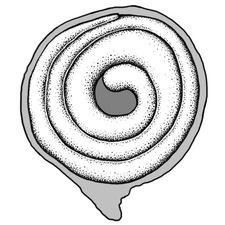 , peripheralperipheral:
, peripheralperipheral:
(of embryo) embryo is curved around the outer edge of the seed, near the seed coat
.
Endosperm scanty to absent. Perispermperisperm:
seed nutritive tissue comparable to the endosperm, but derived from the nucellus (maternal tissue)
copious to scanty.
Can be a common weed in upland fields and difficult to control. Some species will form dense, large clumps or predominant populations in both in moist or drought habitats. It can endure poor-nutrition soil surroundings and many harsh environments. Spreads by seed reproduction. Amaranthus spinosus is considered noxious in Georgia and Indiania and invasive in many countries around the world. Amaranthus palmeri is considered noxious in Iowa, Ohio, Minnesota, Montana, North Dakota, South Dakota, Tennessee, Washington, and Wisconsin.
Noxious Weed: USA Federal Noxious Weed List, terrestrial, Alternanthera sessilis (Linnaeus) R. Brown ex de Candolle, Salsola vermiculata L.
Federal Noxious Weed Disseminules of the US tool provides descriptions and images of these species. Although listed as a terrestrial weed, Alternanthera sessilis is found predominately in wet places. More about Alternanthera on Aquarium & Pond Plants of the World tool.
| Fruit | |
| Type | capsulecapsule: a dry, dehiscent fruit derived from a compound ovary  , utricleutricle: , utricleutricle:a small, indehiscent, dry fruit with a thin wall (bladderlike) that is loose and free from the seed, derived from a single, superior, simple ovary  , berryberry: , berryberry:an indehiscent, fleshy fruit with one or a few to many seeds. The flesh may be homogenous throughout. Or, if the outer part is hard, firm, or leathery, referred to as an hesperidium. Septa are present in some, and the seeds may be arillate or with a fleshy testa.  , acheneachene: , acheneachene:a dry, indehiscent, one-seeded fruit, with seed attached to pericarp at a single point, derived from a single, superior, simple or compound, one-loculed ovary  , nutnut: , nutnut:a fairly large, indehiscent, dry fruit with a thick and bony wall surrounding a single seed, derived from a single, simple or compound ovary  |
| Size range | 0.5–12 mm long (with bracteoles, up to 25 mm) |
| Shape(s) | globoseglobose: 3D shape—more or less spherical  , ellipsoidellipsoid: , ellipsoidellipsoid:3D shape—elliptic , ovoidovoid: 3D shape—ovate  , oblongoblong: , oblongoblong:2D shape—much longer than broad with nearly parallel sides, corners are rounded  , conicalconical: , conicalconical:3D shape—cone-shaped, with the point of attachment at the broad end 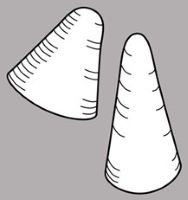 , cylindricalcylindrical: , cylindricalcylindrical:3D shape—a cylinder, with parallel sides and a circular cross-section; tubular or rod-shaped , flask-shapedflask-shaped: 3D shape—generally circular in cross-section, broadest at or below the middle, approximately globose below that and constricted above to a relatively narrow neck , lens-shapedlens-shaped: 2D shape—round and flattened with two curved (convex) surfaces , teardrop-shapedteardrop-shaped: 2D shape—widest point is toward one end of the fruit, the other end tapers sharply to a pointed end 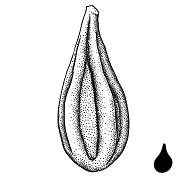 , hemisphericalhemispherical: , hemisphericalhemispherical:2D shape—shaped like half a sphere , plano-convexplano-convex: 2D or 3D shape—flat on one side, convex on the other 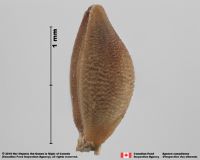 |
| Texture | membranousmembranous: texture—extremely thin, pliable, and fairly tough , hard, leatheryleathery: texture—moderately thick, tough, and very pliable , chartaceouschartaceous: papery, papyraceous , fleshy |
| Surface relief | smooth, vesiculate, ridgedridged: surface relief—raised, thick ridges, sharp edged or rounded, usually in a series that may cover the entire surface  , reticulatereticulate: , reticulatereticulate:surface relief—netted, raised walls or concave grooves forming a net-like surface pattern with flat, concave, or convex interspaces  , punctatepunctate: , punctatepunctate:surface relief—dotted with pits or with translucent, sunken glands or with colored dots, similar to pitted  , papillosepapillate: , papillosepapillate:surface relief—bearing minute, distinct, broad-based projections, tapering to a rounded apex  , alveolate-wrinkled, wartywarty: , alveolate-wrinkled, wartywarty:surface relief—distinct, rounded projections that are large relative to the fruit size; tuberculate, verrucose  , crenulatecrenulate: , crenulatecrenulate:finely crenate (scalloped) , horned, spinyspiny: having slender, stiff, sharp projections oriented in the general plane of the structure 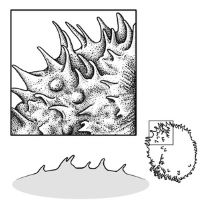 |
| Color(s) | brown, gray, green, yellow, red, orange, white |
| Unique features | One-seeded fruits often with persistent, sharp and hard or soft and blunt, bracts or perianthsperianth: collective term for calyx and corolla of a flower  . If soft and blunt, then fruit wall usually scariousscarious: . If soft and blunt, then fruit wall usually scariousscarious:texture—dry, thin, membranous, non-green, more or less translucent and easily removed. Rarely capsulescapsule: a dry, dehiscent fruit derived from a compound ovary  with circumscissilecircumscissile: with circumscissilecircumscissile:(~pyxis); type of capsular dehiscence, opens by a lid (splitting transversely)  dehiscence with two or three stylestyle: dehiscence with two or three stylestyle:in a flower, the narrow and elongated part of the pistil between the stigma and the ovary; sometimes persisting in fruit  remnants at the apexapex: remnants at the apexapex:the point farthest from the point of attachment, or the "tip" of an organ  . . |
| Seed | |
| Size range | 0.3–1.5 mm long |
| Shape(s) | globoseglobose: 3D shape—more or less spherical  , oblongoblong: , oblongoblong:2D shape—much longer than broad with nearly parallel sides, corners are rounded  , ovoidovoid: , ovoidovoid:3D shape—ovate  , lens-shapedlens-shaped: , lens-shapedlens-shaped:2D shape—round and flattened with two curved (convex) surfaces , cuneiformcuneiform: wedge-shaped , reniformreniform: 2D or 3D shape—kidney-shaped  |
| Surface relief | smooth, ribbedribbed: surface relief—wide, prominent, linear ridges that are generally rounded and longitudinally situated on the surface  , tuberculatetuberculate: , tuberculatetuberculate:surface relief—bearing small, warty, swelling, rounded, or variously shaped projections  , wrinkledwrinkled: , wrinkledwrinkled:surface relief—shallow, irregular folds and furrows covering the surface; appearing overall though crumpled and then spread out  , papillatepapillate: , papillatepapillate:surface relief—bearing minute, distinct, broad-based projections, tapering to a rounded apex  , reticulatereticulate: , reticulatereticulate:surface relief—netted, raised walls or concave grooves forming a net-like surface pattern with flat, concave, or convex interspaces  , alveolatealveolate: , alveolatealveolate:surface relief—reticulated, honeycombed; ridges that intersect to form polygonal cells with a regular size and shape similar to a honeycomb  , spinyspiny: , spinyspiny:having slender, stiff, sharp projections oriented in the general plane of the structure  |
| Color(s) | usually black or brown, sometimes orange, yellow, white, purple, green |
| Unique features | Frequently lens-shapedlens-shaped: 2D shape—round and flattened with two curved (convex) surfaces or reniformreniform: 2D or 3D shape—kidney-shaped  , black or brown, shinyshiny: , black or brown, shinyshiny:uniformly reflecting a high proportion of incident light at all angles  seeds with horseshoe-shapedhorseshoe-shaped: seeds with horseshoe-shapedhorseshoe-shaped:3D shape—relatively slender and strongly compressed, the whole strongly curved over its length in a plane perpendicular to the direction of compression and forming an incomplete circle, the ends somewhat straighter than the rest and parallel or nearly so 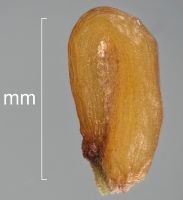 or coiledcoiled: or coiledcoiled:(of embryo) linear embryo is very long and bent to form a coil whereby one end of the embryo is on the outside and the other end near the middle of the seed  embryos visible around the edge of the seeds. embryos visible around the edge of the seeds. |
| Other | |
| Embryo | well developed, often filling or nearly filling seed coat, U-shaped to flatly or conically coiledcoiled: (of embryo) linear embryo is very long and bent to form a coil whereby one end of the embryo is on the outside and the other end near the middle of the seed  , peripheralperipheral: , peripheralperipheral:(of embryo) embryo is curved around the outer edge of the seed, near the seed coat |
| Nutritive tissue | copious to scanty |
Tropical, subtropical and warm temperate regions, often in saline habitats.

Distribution map courtesy of Angiosperm Phylogeny Website.
Flora of North America Editorial Committee 1993+Flora of North America Editorial Committee 1993+:
Flora of North America Editorial Committee, eds. 1993+. Flora of North America North of Mexico [Online]. 22+ vols. Flora of North America Association, New York and Oxford. Accessed January-March 2024. URL: http://beta.floranorthamerica.org.; Judd and Ferguson 1999Judd and Ferguson 1999:
Judd WS and Ferguson IK. 1999. The genera of Chenopodiaceae in the southeastern United States. Harvard Papers in Botany 4 (2): 365&-416. http://www.jstor.org/stable/41761579; Kirkbride et al. 2006Kirkbride et al. 2006:
Kirkbride JH, Jr, Gunn CR, and Dallwitz MJ. 2006. Family guide for fruits and seeds, vers. 1.0. Accessed September 2020-January 2022. URL: https://nt.ars-grin.gov/seedsfruits/keys/frsdfam/index.cfm .; Kubitzki et al. 1990+Kubitzki et al. 1990+:
Kubitzki K et al., eds. 1990+. The families and genera of vascular plants. 7+ vols. Berlin etc.; Noxious Weed Regulations 2020Noxious Weed Regulations 2020:
Noxious Weed Regulations. 2020. 7 C.F.R. sect; 360.100-360.600.; Salete et al. 2022Salete et al. 2022:
Salete Marchioretto M, Windisch PG, and Carlos de Siqueira J. 2022. Os Gêneros Froehlichia Moench E Froelichiella R.E. Fries (Amaranthaceae) No Brasil. Pesquisas. Botânica 52: 7-46.; Shishkin 1970Shishkin 1970:
Shishkin BK, volume editor. 1970. Vol 6. Centrospermae. In: Flora of the Union of Soviet Socialist Republics, Komarov VL, chief ed. Botanical Institute of the Academy of Sciences of the U.S.S.R. Moskov-Leningrad. (1936). Translated by Dr. N. Landau, Israel Program for Scientific Translations Ltd. in agreement with The Smithsonian Institute and NSF.; USDA 1980USDA 1980:
United States Dept. of Agriculture (USDA). 1980. Major weed family identification guide. Hyattsville Md, United States ; Zhengyi et al. 2004+Zhengyi et al. 2004+:
Zhengyi W, Raven PH, and Deyuan H. 2004+. Flora of China [online]. 25 vols. Science Press, Beijing China & Missouri Botanical Garden, St. Louis USA. Accessed January–March 2024. http://flora.huh.harvard.edu/china/
*The number of genera and species is based on Christenhusz and Byng 2016Christenhusz and Byng 2016:
Christenhusz MJM and Byng JW. 2016. The number of known plant species in the world and its annual increase. Phytotaxa 261 (3): 201-217. https://doi.org/10.11646/phytotaxa.261.3.1, which may differ from the number of genera in GRIN-Global.